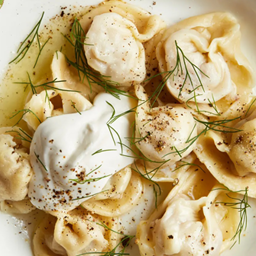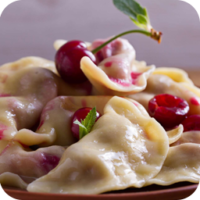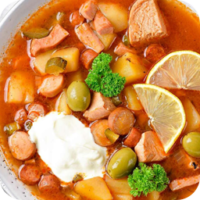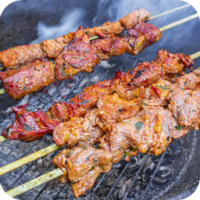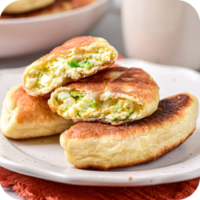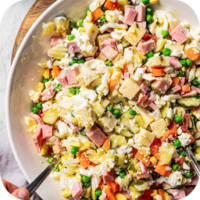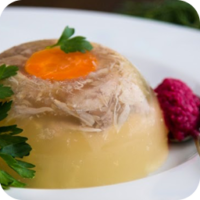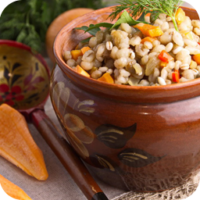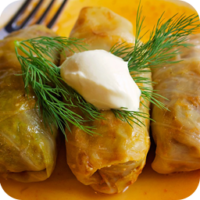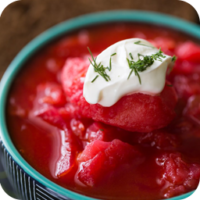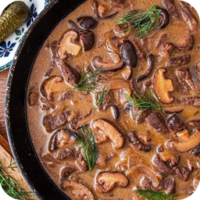Pelmeni (пельмени) are traditional Russian dumplings that are typically made with a simple dough and filled with a mixture of meat, such as beef, pork, or lamb. These dumplings are a staple in Russian cuisine and are similar to other dumplings found in Central Asia, but with distinct Russian flavors and preparation methods. The dumplings are boiled and often served with sour cream, butter, or vinegar, making them a comforting and hearty dish.
Key Ingredients:
- Dough:
- The dough is usually made from flour, water, egg, and a pinch of salt. It’s rolled out thin and cut into small circles, which are used to encase the filling.
- Meat Filling:
- The traditional filling is made from a mixture of ground beef, pork, or lamb. Sometimes a mix of onions, garlic, and spices (like black pepper and salt) is added to enhance the flavor.
- Seasonings:
- Onions are commonly mixed into the meat to give it additional flavor, and a bit of garlic and pepper are used to season the filling. Some recipes also add a bit of water or broth to the filling to make it juicier.
- Serving Options:
- Pelmeni are typically served with sour cream, butter, or vinegar for extra flavor. They may also be topped with chopped herbs, such as dill or parsley.
Flavor Profile:
- The dough is soft, slightly chewy, and neutral, allowing the rich, savory filling to shine. The meat filling is flavorful, juicy, and savory, with a mild kick from the seasonings like black pepper and garlic. When served with sour cream or butter, pelmeni becomes rich and creamy, making it a hearty and satisfying dish.
How It’s Made:
- Prepare the Dough:
- The dough is mixed by combining flour, egg, water, and a pinch of salt. It is kneaded until smooth and allowed to rest for about 30 minutes to make it easier to roll out.
- Prepare the Filling:
- The meat is ground and mixed with onions, salt, pepper, and any other seasonings. Some recipes also include a bit of broth or water to make the filling more juicy.
- Form the Dumplings:
- The dough is rolled out thin, and small circles are cut from it. A spoonful of the filling is placed in the center of each circle, and the dough is folded over to seal the filling inside, forming a half-moon or round shape. The edges are pinched together to seal.
- Cook the Pelmeni:
- The pelmeni are boiled in a large pot of salted water for about 5-7 minutes, or until they float to the surface, indicating they are cooked. They can also be pan-fried after boiling for a crispy texture on the outside.
- Serve:
- Pelmeni are typically served hot with a dollop of sour cream, a bit of butter, or a splash of vinegar. They are sometimes garnished with chopped dill or parsley.
Cultural Significance:
- Pelmeni have deep roots in Russian cuisine, particularly in the Siberian and Ural regions. The dish is said to have originated with the indigenous peoples of Siberia and was adopted by Russian cuisine over the centuries.
- In Russia, pelmeni are considered comfort food and are often served during family gatherings or holidays.
- They are also a popular winter food in Russia because they are filling and can be stored in large quantities in the freezer, making them an easy meal to prepare during cold months.
Variations:
- Meat Mixes:
- While the classic version of pelmeni uses beef and pork, variations may include lamb, chicken, or venison.
- Vegetarian Pelmeni:
- A vegetarian version can be made with mushrooms, potatoes, or cabbage as the filling.
- Pan-Fried Pelmeni:
- After boiling, pelmeni can be pan-fried in butter or oil to create a crispy, golden exterior.
- Pelmeni Soup:
- Sometimes, pelmeni are served in a rich broth, making them a comforting soup dish.
Health Benefits:
- Protein-rich: Pelmeni are a good source of protein, particularly when made with meat fillings like beef or pork.
- Comforting: With the buttery or creamy toppings, pelmeni provide a hearty meal that is both filling and satisfying.
- Customizable: For a healthier twist, pelmeni can be made with leaner meats or even vegetarian fillings.

